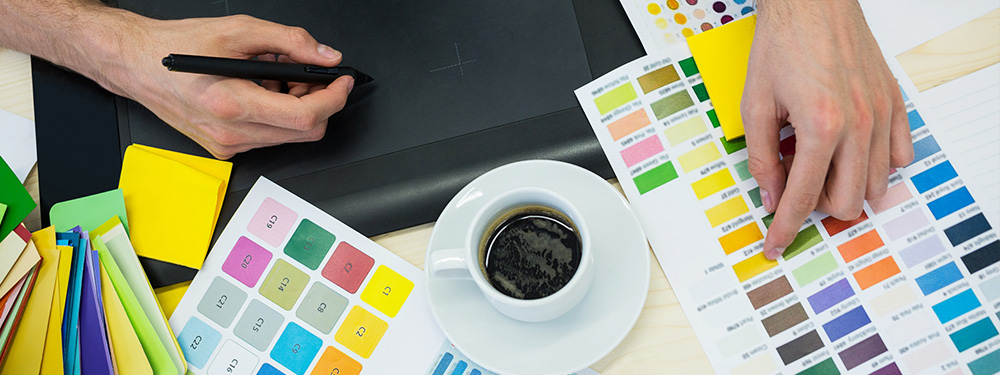Designing a logo is easy, right? Wrong. So, so, very wrong. A logo serves as a brand’s visual identity and there’s so much more to creating a logo than just slapping the company name in a colored box and calling it a day.
To consumers, a company’s logo reminds them who the company is and what they do.
To the company, a logo is a visual representation of who they are and what they stand for. Their logo is part of their brand’s voice.
To designers, a logo is a challenge. You know what we’re talking about if you’ve ever tried incorporating an entire organization’s ideologies and values into a single graphic.
No matter your relation to logos, we can all probably agree that logos are important. The fact that they’re so important is what inspired us to write this post and share some easy to follow advice about designing logos. We hope you learn something new and exciting today!
If you have a question about something you read here, don’t hesitate to reach out or leave a comment. We love talking about graphic design around here.

An Easy-Read Guide About Logo Design
- Your logo has to be simple. Simple logos are easy to recognize, versatile, and memorable. The best logos feature something unique or unexpected without being overdone.
- Your logo has to be evergreen. You’ve heard of evergreen content, right? Evergreen content is content that stays relevant to your customers. Just like the content you create, your logo should be evergreen too. The logo your client is using today should still be relevant 20+ years from now.
- Your logo should match your client’s voice. The way a logo is positioned should be appropriate for the company’s target audience, every intended use of the logo, and the voice they’re trying to establish.
- Design briefs are important. When you’re designing a logo for a client, it’s important to ask questions for a design brief so you have a reference guide while working.
- Research is always necessary. In order to design the perfect logo for a client, you’ve got to do your homework. Research the industry your client operates in, its history and competitors.
- Look for inspiration everywhere. Look at websites, successful trends, current trends, and current styles related to what you put together in your design brief.
- Cliches should be avoided at all costs. Idea light bulbs and international globes are so overdone. Be original. Be clever. Think outside the box.
- You better be picky about the typeface you choose. Good typography is essential to a good logo and you’ve got two options: create your own typeface or adapt an existing one. Whatever you choose, just make sure it’s simple, legible and matches the brand.
- You have to remember to take breaks. No designer has ever successfully completed a logo design in a single sit-down. It’s okay to take breaks while designing logos, heck, it’s even recommended. Breaks give your ideas time to mature and your client the opportunity to provide you with feedback.
- Limit options. When you present a logo idea to a client, we suggest never giving them more than designs to look at. Too many options at once can be overwhelming. Let your client see what you’ve come up with, take their feedback, and repeat until they see what they want (within reason of course).

Don’t Forget About Color, Color can make or break your logo design. Every color in the color wheel implies something different. Don’t convey the wrong message when designing a logo by picking the wrong color(s). The Science Behind Color, an article by The Logo Company, serves as an excellent resource when choosing colors for a project. For example:
BLACK is a color best suited for the marketing, financial, and corporate industries. It is most often associated with qualities such as strength, power, and precision.
BLUE is a color best suited for tech, health-care, and government. It is most often associated with qualities such as clean, calm, and professional.
ORANGE is a color best suited for sports, entertainment, and food and drink. It is most often associated with qualities such as energy, creativity, and youthfulness.
Yay for bonus tips! You can learn about other colors by reading the article linked above.
But more importantly, you read this article so that means you’re one of two people:
- A designer who’s bright, shiny and new. You’re gearing up for your first logo design project. That’s awesome! We’re glad you stopped by our blog.If you’d like to continue learning about logo design, we suggest reading:
2016 Logo Design Trends & Inspiration
11 Brilliant Resources for Logo Designers
10 Tips for Designing Logos That Don’t Suck
Don’t be shy about letting us know if you found this article useful or have a tip you think should be included. Leave your two-cents in the comments section. - A new business owner who’s trying to figure out all this branding and logo stuff.
If this is you, let’s talk! We’d be thrilled to help you create the best logo for your brand. Shoot us a message or give us a ring and let’s get started!
or
Design community: What are some of your favorite logo designs? Let’s get a discussion going.





Leave a Reply
Want to join the discussion?Feel free to contribute!